The last ruler of the house of Trastamara, Joanna, known natively as Juana, of Castile was the daughter of two brilliant, but ruthless monarchs--Queen Isabella of Castile, and King Ferdinand of Aragon. She married Philip, Duke of Burgundy, and scion of the house of Habsburg. She was a brilliant woman, speaking five languages, excelling in math, science, and philosophy. Yet when she inherited the throne of Castile in 1516 she found herself shoved aside, and imprisoned as a madwoman by her father and her husband, both of whom were deadlocked in a struggle for her crown.
The modern Iberian Peninsula has only three countries--Spain, Portugal, and Andorra, but when Joanna's parents took the throne the peninsula was fractured and split between the kingdoms of Castile, Aragon, Portugal, Navarre, Andorra, and the Muslim controlled Andalus. When Ferdinand and Isabella married in 1469 they united Castile and Aragon, creating a country that contained almost all of the territory of modern Spain. Though they were supposedly equal monarchs, on paper and in practice Isabella ran the whole show. So when she died in 1504, and left Castile to her daughter Joanna, Ferdinand's dreams of an united Espana were endangered.
To understand Joanna as an adult, you have to understand Joanna as a child. Joanna was, very much, a Renaissance princess. Like her sister, Catherine of Aragon, and later her daughter, Mary of Hungary, Joanna was given a full Humanist education. She was taught math, science, philosophy, writing, religious and secular law, as well as five languages--French, Latin, Castilian, Catalan, and Galaico-Portuguese. She was very bright, arguably the brightest of Ferdinand and Isabella's children, a fact that no doubt led her to questioning the Catholic faith.
Now, given that Isabella and Ferdinand had commited mass genocide on several continents in the name of Catholicism, to have a daughter who questioned their austere faith was completely unacceptable. Letters from Ferdinand's attendants report that Joanna was subjected to torture in order to correct her unorthodoxy.
Like all royal women of the age, Joanna was expected to make a brilliant marriage, and strengthen Spanish ties with a suitable foreign power. For Joanna, that power was the Habsburg family, the family that, at the time, ruled modern Germany, Austria, and much of the Benelux area. Maximilian I was head of the family at the time, and he had a single son, Philip, Duke of Burgundy.
Philip was later referred to as 'Philip the Handsome', and that sums up his character excellently. Philip was handsome; he liked women, wine, and sport. He didn't care much for affairs of state, and he especially didn't care much for fidelity in marriage, a fact which would torment Joanna all her life.
However, when the pair first met in 1496 the dark clouds of infidelity and alleged mental illness were nowhere in sight. Upon clapping eyes on each other, the pair were overcome with lust. They immediately summoned a priest, and had their marriage blessed, not even waiting for the official wedding the day after to consummate their union. Unsurprisingly, the pair had six children.
For the first years of their marriage Joanna and Philip lived in Burgundy. Joanna enjoyed the freedom and relaxed atmosphere of the Lowlands, but unfortunately gained herself no real political allies. Though she had been tasked to advance Spain's interests by her mother, Joanna had no real interest in playing politics at this point in her life, she was more worried about wrangling her philandering husband, who had the habit of attempting to seduce everything that walked.
At the time, fidelity wasn't necessarily expected from royal men. Political marriages like Joanna and Philip's were based on the unspoken agreement that so long as there were a few heirs in the royal nursery, the man was allowed to do whatever (or whoever) he wished. The woman, on the other hand, was expected to remain faithful to her husband, and occupy her time with her children and charity projects. Joanna's mother, Isabella, understood this. Ferdinand had at least four children outside of marriage, and Isabella hadn't made a scene. Joanna, on the other hand, was in love with her husband, and wasn't going to stand for his philandering. The couple descended into a toxic cycle of her catching him being unfaithful, her yelling at him, then him avoiding her and having her confined to her rooms. Joanna's passionate outbursts and tempestuous reactions to her husband's behavior were recorded, and later used against her as evidence of her 'insanity', especially after she physically attacked one of Philip's many mistresses.
Back in Spain Trastamara's were dropping like flies. Joanna had never been expected to inherit her mother's throne, but with the death of her brother, Juan, in 1497, and her older sister, Isabella in 1498 Joanna was set to inherit a large chunk of the Iberian Peninsula--probably.
Problem was, women could not legally inherit in Aragon, the country of Joanna's father. While Joanna did have a son, Charles (later Holy Roman Emperor Charles V), he was still a child, and should Ferdinand die before Charles reached majority the issue of who would rule Aragon became unclear.
Enter Philip. Young and already ruling a duchy of his own, Philip was eager to add to his father's empire by taking Spain off the hands of the Trastamara's. This, however, didn't sit well with Isabella or Ferdinand, neither of whom wanted their country to go to a foreigner. Worried that Castile would end up in Philip's hands, Isabella added a codicil to her will that allowed Ferdinand to rule in Joanna's stead should Joanna die or leave Spain, cutting Philip out of the deal altogether.
When Isabella died in 1506 Ferdinand immediately had his daughter declared queen in Madrid, and around Castile. When word reached Joanna and Philip in Brussels, the pair had themselves declared sovereigns of Castile, and started the long journey to Madrid.
Though he was outwardly supportive of his daughter, Ferdinand started undermining her almost immediately. He seized state revenues, and circulated rumors that she was insane, producing the reports sent from Burgundy to back up his claims.
The Cortes--the Spanish Courts--declared Ferdinand custodian of Castile, and Ferdinand and his bishops started working on persuading Joanna to declare her father her regent. Philip, meanwhile, had landed in northern Spain, and was making his way to Madrid with Joanna. He had himself declared king in every town he went through, and seized revenues and assigned government positions to favored supporters. He was determined to become king, and he had come prepared. Protecting Philip was 2,000 German mercenaries, practically an army.
Joanna, on the other hand, was in a state of distress. Philip had told her of her father's attempts to rob her of her throne. However, she hadn't heard from her father directly, and she had witnessed her husband's attempts to steal her throne first hand. Joanna was much more inclined to trust her father than her husband, and refused to take any serious action until she's spoken with Ferdinand herself. She dressed in black in protest, and refused to appear at any oath swearing ceremony, or proclaim her husband King.
There was no doubt to Joanna that she was queen. She had been left the throne by her mother, and she intended to rule. The only problem was that nobody seemed to want her to rule. While she had some support among the populace, her strange attire and absence from the public eye isolated her from any real political supporters. She was caught between two very politically ambitious men, one of whom was wily and experienced, the other of whom had a large army and a political heavyweight for a father. Both parties owned a penis which, as so often is the case, made them both a more popular candidate than Joanna herself.
In order to keep Joanna away from her father, Philip had her confined to her rooms, and kept under guard. Both Philip and Joanna issued edicts under Joanna's name, and the pair were inches away from declaring war. Eventually, the King of France, stepped in to mediate. Ferdinand conceded to Philip, giving up all claims to Castile, and both men had Joanna declaed mad, and unfit to rule.
Philip took the reigns of power in Castile, and Ferdinand retreated to his holdings in Naples. Philip didn't have long to enjoy his power though, because in the fall of 1506 he died abruptly from a fever, leaving his wife six months pregnant.
With her father in Naples and her husband dead, Joanna was closer to holding her throne than she had ever been. She was pregnant, which put her in a precarious position, but Joanna was unwilling to let the Spanish nobility take the throne from her. She stayed in seclusion for three months after her husband's death, and upon emerging took his body on a cross country processional to prepare for burial.
This journey through Spain is one of the stranger episodes of Joanna's life. Historians, as well as Joanna's contemporaries, are baffled by her motives for dragging a corpse across Spain while more than six months pregnant. While one would have to ask Joanna herself to be sure, there are several theories.
The most popular and prevalent theory is that Joanna was capital C crazy, and that she had finally come unhinged. Stories of her flinging her body upon her husband's lifeless corpse and weeping hysterically spread around the countryside. This report, while likely propaganda put out by Ferdinand, and later Joanna's son Charles, is substantiated by the fact that Joanna did have Philip's casket opened several times on the journey.
Another theory is that Joanna was traveling as an act of calculated defiance. After being apart from her people for so long Joanna was showing herself and the dead 'king' to remind the populace of her son and heir, Charles. Joanna had Philip's casket opened to prove that she did, indeed, possess his remains. This would have been seen as a message to Ferdinand that while he may wish to rule Castile, Joanna wasn't going to go quietly.
Both theories have merit, and fall on opposing sides of the debate that always arises whenever Joanna is mentioned--was Joanna insane, or merely the unlucky pawn of two rulers. However, this historian would like to pose a third theory (and a third answer to that question), that being that taking Philip's body on a tour of Spain was a stalling tactic on Joanna's part. Much like Penelope weaving her husband's burial shroud, then undoing her work in the dead of night, Joanna was putting off contracting a second marriage. The 'Queen' of Castile was quite the catch, and there were several rulers out for her hand (including Henry VII, her sister Catherine's father-in-law). By prolonging her mourning, and taking her time to bury Philip's body, Joanna bought time for herself to find a solution that suited her.
It was her pregnancy that eventually brought Joanna back into her father's clutches. Joanna gave birth to her youngest daughter Catalina in January of 1507, and afterwards Ferdinand sent his men to have her confined to a nunnery in Tordesillas. It was there that she stayed for the rest of her life.
The rest of Joanna's life was spent in captivity at Tordesillas, the only changes being her jailers and the man who usurped her throne. While in Tordesillas, Joanna was physically and emotionally abused, and denied visitors. Her only companion was her daughter, Catalina, who was stolen away and married off in 1525. Much of the money that was to be spent on Joanna's food and clothing was stolen by unscrupulous jailers, and she was purposely kept out of the loop on important events in order to make her seem insane. When Ferdinand died in 1516 Joanna was not told. She died believing that her father was still alive.
When Ferdinand died in 1516 Joanna's son, Charles, inherited Aragon. Since his mother was still alive Charles could not legally take control of Castile, so, like his grandfather, Charles kept his mother imprisoned, and had rumors of her continued insanity spread around Europe. Charles ruled as her regent for nearly 40 years.
Joanne died on Good Friday of 1555 at the age of 75. She was quietly buried, and almost immediately forgotten. Charles, now Holy Roman Emperor, would rule for another three years before abdicating in favor of his brother, Ferdinand. Joanna never saw her children again.
Joanna has gone down in history as 'Joanna the Mad'. She's little more than an historical footnote, only referred to when talking about the many genetic issues of the Habsburg family. She is frequently blamed as being the origin of the many mentally ill Habsburgs, perhaps not without reason. Joanna's grandmother, Isabella of Portugal, Queen of Castile suffered from severe depression, as did many of Joanna's descendents. However, upon close inspection, contemporary claims of her insanity dissipate into dust, revealing a passionate, but naive woman who had the misfortune to be surrounded by people who loved power more than her.
Probably. While claims of Joanna being a stark raving mad woman who groped corpses and violently accosted innocent maidens, it is highly unlikely that she was completely sane. It would, in fact, be insane, if a person who had been tortured as a child, physically and emotionally abused, gaslit, and neglected most of her life died happy and well adjusted. It seems likely that Joanna did suffer from sort of mental illness; there are reports of her falling into melancholy and refusing to eat or move. The real question is which came first: the abuse or the mental illness?
Sources
The Tragic Story of Joanna the Mad by Fernando Espi Forcen, M.D., Department of Psychiatry, The University of Chicago
Juana 'The Mad' Queen of a World Empire by Lisa Andrean
Was Joanna of Castile Truly 'Mad' or a Pawn For the Men in Her Family?
Joan, Queen of Castile
Juana the Mad of Castile
House of Habsburg
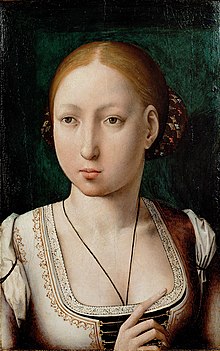 |
| Joanna was the third child of Ferdinand and Isabella. |
To understand Joanna as an adult, you have to understand Joanna as a child. Joanna was, very much, a Renaissance princess. Like her sister, Catherine of Aragon, and later her daughter, Mary of Hungary, Joanna was given a full Humanist education. She was taught math, science, philosophy, writing, religious and secular law, as well as five languages--French, Latin, Castilian, Catalan, and Galaico-Portuguese. She was very bright, arguably the brightest of Ferdinand and Isabella's children, a fact that no doubt led her to questioning the Catholic faith.
Now, given that Isabella and Ferdinand had commited mass genocide on several continents in the name of Catholicism, to have a daughter who questioned their austere faith was completely unacceptable. Letters from Ferdinand's attendants report that Joanna was subjected to torture in order to correct her unorthodoxy.
 |
| Europe, 1500 |
Philip was later referred to as 'Philip the Handsome', and that sums up his character excellently. Philip was handsome; he liked women, wine, and sport. He didn't care much for affairs of state, and he especially didn't care much for fidelity in marriage, a fact which would torment Joanna all her life.
However, when the pair first met in 1496 the dark clouds of infidelity and alleged mental illness were nowhere in sight. Upon clapping eyes on each other, the pair were overcome with lust. They immediately summoned a priest, and had their marriage blessed, not even waiting for the official wedding the day after to consummate their union. Unsurprisingly, the pair had six children.
 |
| Philip the 'Handsome' |
At the time, fidelity wasn't necessarily expected from royal men. Political marriages like Joanna and Philip's were based on the unspoken agreement that so long as there were a few heirs in the royal nursery, the man was allowed to do whatever (or whoever) he wished. The woman, on the other hand, was expected to remain faithful to her husband, and occupy her time with her children and charity projects. Joanna's mother, Isabella, understood this. Ferdinand had at least four children outside of marriage, and Isabella hadn't made a scene. Joanna, on the other hand, was in love with her husband, and wasn't going to stand for his philandering. The couple descended into a toxic cycle of her catching him being unfaithful, her yelling at him, then him avoiding her and having her confined to her rooms. Joanna's passionate outbursts and tempestuous reactions to her husband's behavior were recorded, and later used against her as evidence of her 'insanity', especially after she physically attacked one of Philip's many mistresses.
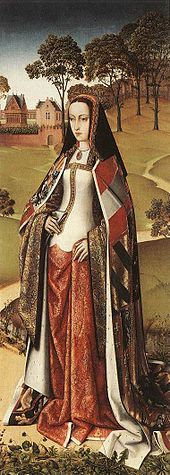 |
| Joanna, 1500 |
Problem was, women could not legally inherit in Aragon, the country of Joanna's father. While Joanna did have a son, Charles (later Holy Roman Emperor Charles V), he was still a child, and should Ferdinand die before Charles reached majority the issue of who would rule Aragon became unclear.
Enter Philip. Young and already ruling a duchy of his own, Philip was eager to add to his father's empire by taking Spain off the hands of the Trastamara's. This, however, didn't sit well with Isabella or Ferdinand, neither of whom wanted their country to go to a foreigner. Worried that Castile would end up in Philip's hands, Isabella added a codicil to her will that allowed Ferdinand to rule in Joanna's stead should Joanna die or leave Spain, cutting Philip out of the deal altogether.
When Isabella died in 1506 Ferdinand immediately had his daughter declared queen in Madrid, and around Castile. When word reached Joanna and Philip in Brussels, the pair had themselves declared sovereigns of Castile, and started the long journey to Madrid.
Though he was outwardly supportive of his daughter, Ferdinand started undermining her almost immediately. He seized state revenues, and circulated rumors that she was insane, producing the reports sent from Burgundy to back up his claims.
 |
| Map of the Iberian Peninsula in Joanna's lifetime. Missing is Andorra. |
Joanna, on the other hand, was in a state of distress. Philip had told her of her father's attempts to rob her of her throne. However, she hadn't heard from her father directly, and she had witnessed her husband's attempts to steal her throne first hand. Joanna was much more inclined to trust her father than her husband, and refused to take any serious action until she's spoken with Ferdinand herself. She dressed in black in protest, and refused to appear at any oath swearing ceremony, or proclaim her husband King.
There was no doubt to Joanna that she was queen. She had been left the throne by her mother, and she intended to rule. The only problem was that nobody seemed to want her to rule. While she had some support among the populace, her strange attire and absence from the public eye isolated her from any real political supporters. She was caught between two very politically ambitious men, one of whom was wily and experienced, the other of whom had a large army and a political heavyweight for a father. Both parties owned a penis which, as so often is the case, made them both a more popular candidate than Joanna herself.
In order to keep Joanna away from her father, Philip had her confined to her rooms, and kept under guard. Both Philip and Joanna issued edicts under Joanna's name, and the pair were inches away from declaring war. Eventually, the King of France, stepped in to mediate. Ferdinand conceded to Philip, giving up all claims to Castile, and both men had Joanna declaed mad, and unfit to rule.
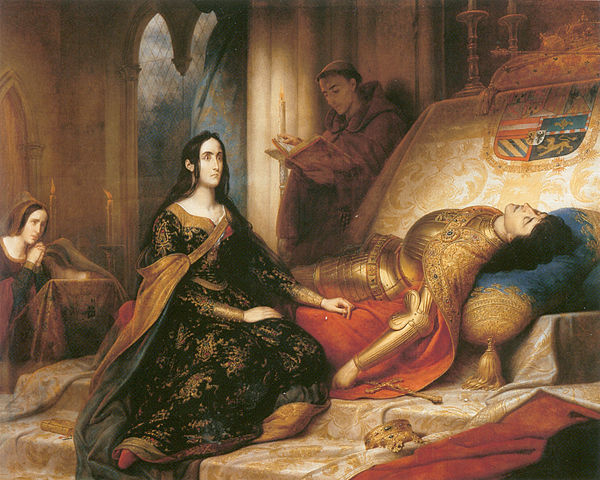 |
| Joanna attending Philip's casket, painted by Charles de Steuben |
With her father in Naples and her husband dead, Joanna was closer to holding her throne than she had ever been. She was pregnant, which put her in a precarious position, but Joanna was unwilling to let the Spanish nobility take the throne from her. She stayed in seclusion for three months after her husband's death, and upon emerging took his body on a cross country processional to prepare for burial.
This journey through Spain is one of the stranger episodes of Joanna's life. Historians, as well as Joanna's contemporaries, are baffled by her motives for dragging a corpse across Spain while more than six months pregnant. While one would have to ask Joanna herself to be sure, there are several theories.
The most popular and prevalent theory is that Joanna was capital C crazy, and that she had finally come unhinged. Stories of her flinging her body upon her husband's lifeless corpse and weeping hysterically spread around the countryside. This report, while likely propaganda put out by Ferdinand, and later Joanna's son Charles, is substantiated by the fact that Joanna did have Philip's casket opened several times on the journey.
Another theory is that Joanna was traveling as an act of calculated defiance. After being apart from her people for so long Joanna was showing herself and the dead 'king' to remind the populace of her son and heir, Charles. Joanna had Philip's casket opened to prove that she did, indeed, possess his remains. This would have been seen as a message to Ferdinand that while he may wish to rule Castile, Joanna wasn't going to go quietly.
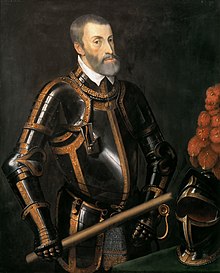 |
| Charles V, Joanna's son and heir |
It was her pregnancy that eventually brought Joanna back into her father's clutches. Joanna gave birth to her youngest daughter Catalina in January of 1507, and afterwards Ferdinand sent his men to have her confined to a nunnery in Tordesillas. It was there that she stayed for the rest of her life.
The rest of Joanna's life was spent in captivity at Tordesillas, the only changes being her jailers and the man who usurped her throne. While in Tordesillas, Joanna was physically and emotionally abused, and denied visitors. Her only companion was her daughter, Catalina, who was stolen away and married off in 1525. Much of the money that was to be spent on Joanna's food and clothing was stolen by unscrupulous jailers, and she was purposely kept out of the loop on important events in order to make her seem insane. When Ferdinand died in 1516 Joanna was not told. She died believing that her father was still alive.
When Ferdinand died in 1516 Joanna's son, Charles, inherited Aragon. Since his mother was still alive Charles could not legally take control of Castile, so, like his grandfather, Charles kept his mother imprisoned, and had rumors of her continued insanity spread around Europe. Charles ruled as her regent for nearly 40 years.
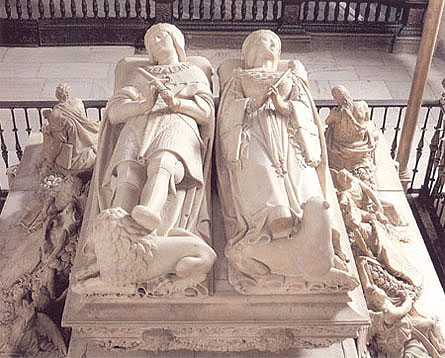 |
| Joanna was buried next to her husband in Tordesillas. |
Joanna has gone down in history as 'Joanna the Mad'. She's little more than an historical footnote, only referred to when talking about the many genetic issues of the Habsburg family. She is frequently blamed as being the origin of the many mentally ill Habsburgs, perhaps not without reason. Joanna's grandmother, Isabella of Portugal, Queen of Castile suffered from severe depression, as did many of Joanna's descendents. However, upon close inspection, contemporary claims of her insanity dissipate into dust, revealing a passionate, but naive woman who had the misfortune to be surrounded by people who loved power more than her.
Probably. While claims of Joanna being a stark raving mad woman who groped corpses and violently accosted innocent maidens, it is highly unlikely that she was completely sane. It would, in fact, be insane, if a person who had been tortured as a child, physically and emotionally abused, gaslit, and neglected most of her life died happy and well adjusted. It seems likely that Joanna did suffer from sort of mental illness; there are reports of her falling into melancholy and refusing to eat or move. The real question is which came first: the abuse or the mental illness?
Sources
The Tragic Story of Joanna the Mad by Fernando Espi Forcen, M.D., Department of Psychiatry, The University of Chicago
Juana 'The Mad' Queen of a World Empire by Lisa Andrean
Was Joanna of Castile Truly 'Mad' or a Pawn For the Men in Her Family?
Joan, Queen of Castile
Juana the Mad of Castile
House of Habsburg

Portugal, was, by then a full independent country, not a part of the fractured Spain.
ReplyDeleteThank you for this!!!! Even a casual glance at Juana's life raises an eyebrow at the glib labeling of her as "insane".
ReplyDelete